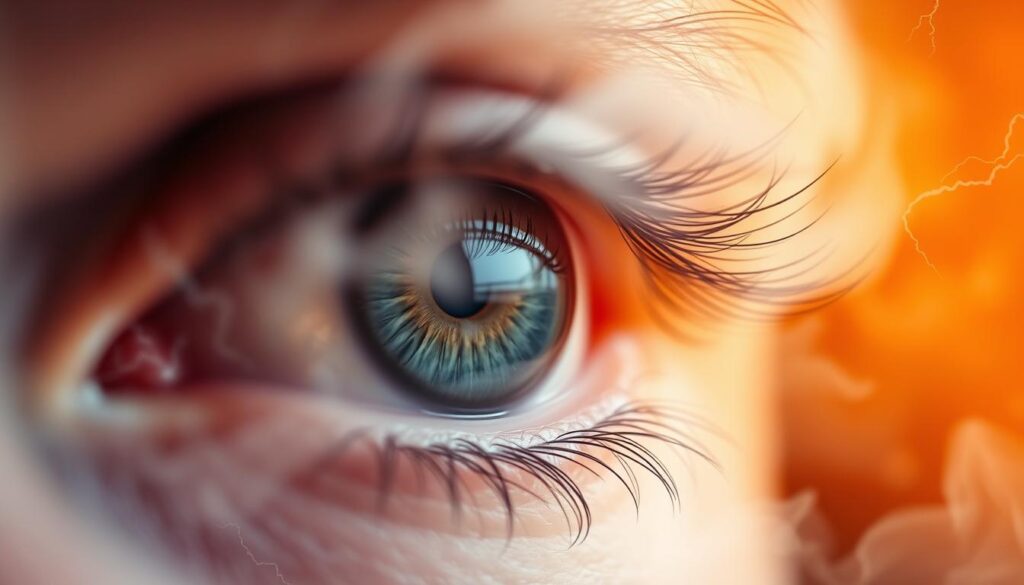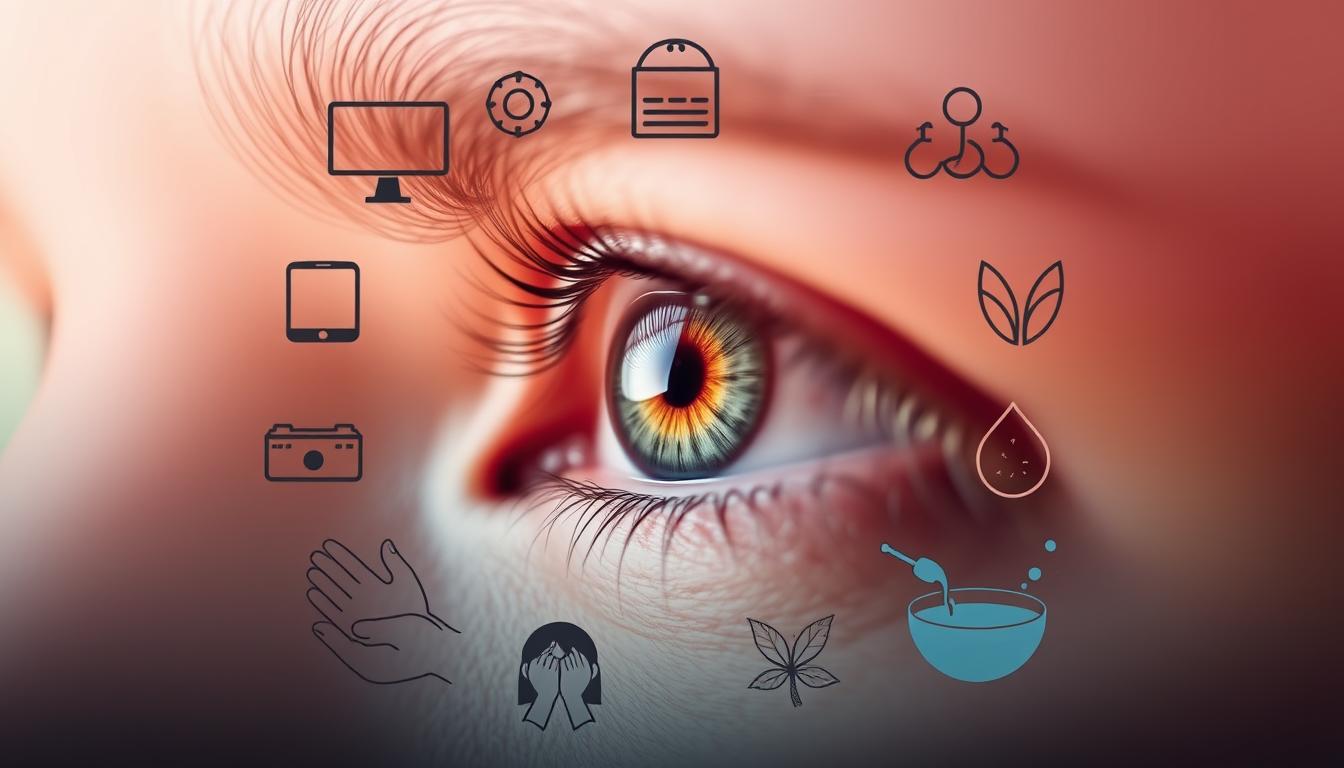Have you ever felt intermittent eye pain without warning? This kind of eye discomfort can make you wonder why it happens and how to stop it. It’s important to know why your eyes hurt sometimes to find the best way to feel better. This article will cover the main reasons for eye pain that comes and goes. You’ll learn about everything from simple irritants to serious health issues. Knowing when to get help is key to keeping your eyes healthy.
Key Takeaways
- Intermittent eye pain can come from many things, like allergies or infections.
- Knowing the signs can help tell apart minor and serious problems.
- Getting help quickly is important, especially for bad or ongoing eye pain.
- Home remedies and good eye care can help ease the pain.
- It’s vital to know the signs of serious issues like glaucoma or optic neuritis.
- Things like eye strain and wearing contact lenses can also cause eye discomfort.
Understanding Intermittent Eye Pain
Eye pain that comes and goes can be mild or severe. It can come from many things. You might feel eye pain from strain or irritants in your environment. Knowing this helps you find ways to ease the pain.
What is Intermittent Eye Pain?
Intermittent eye pain means your eyes hurt now and then. It can be caused by many things, like looking at screens for a long time. This pain can be annoying but usually goes away on its own.
Symptoms Associated with Eye Pain
Eye pain can show in different ways. You might feel:
- Burning or stinging sensations
- Throbbing or sharp discomfort
- Gritty feeling in the eye
- Increased tearing
- Light sensitivity
- Visual disturbances
These symptoms can make everyday tasks hard. Knowing them helps you watch for problems and get help when you need it.
Common Misconceptions about Eye Pain
Not all eye pain is serious. Some think it always means something bad. But, it can come from simple things like allergies or changes in the air. This can cause worry for no reason.
Learning about eye pain can help you take care of your eyes. It lets you deal with discomfort without worrying about big health issues.
| Symptom | Possible Cause |
|---|---|
| Burning Sensation | Dry Eye Syndrome, Allergies |
| Throbbing Pain | Migraine, Cluster Headaches |
| Gritty Feeling | Recurrent Eye Irritation |
| Increased Tearing | Digital Eye Strain, Allergies |
| Light Sensitivity | Uveitis, Optic Neuritis |
Eye Pain Comes and Goes: Common Causes
Understanding why your eye pain comes and goes can help you know when to get help. There are many reasons for this pain, each needing a different way to fix it.
Debris and Foreign Objects in the Eye
Dust or eyelashes can suddenly cause eye pain. This pain usually goes away after you flush your eye. But, if it doesn’t stop, it could mean a corneal scratch. You should see a doctor then.
Eye Infections and Inflammation
Eye infections can cause pain that comes and goes. Conditions like pink eye make your eyes red and watery. You might need antibiotic drops to treat it, so knowing about these eye infections is important.
Migraine and Cluster Headaches
Migraines and cluster headaches can make your eyes hurt. Migraines cause throbbing pain in one or both eyes. Cluster headaches bring sharp pain and can make your eyes tear or droop. Knowing these patterns can help you manage your pain.
Dry Eye Syndrome and Contact Lens Issues
Dry eye syndrome often causes eye strain and discomfort, especially with contact lenses. Not having enough moisture can make your eyes hurt. Using artificial tears and taking good care of your contact lenses can help.
More Severe Conditions: Optic Neuritis and Glaucoma
Conditions like optic neuritis and glaucoma can cause eye irritation. Optic neuritis can change your vision and needs quick medical help. Glaucoma might not hurt at first but can cause severe pain if ignored. Knowing about these conditions helps you know when to get urgent help.

Eye pain could mean something serious. Knowing why it happens lets you act fast. For more on managing pain, check out this useful resource. It talks about the need to see specialists for your pain.
Effective Relief Tips for Eye Pain
Eye pain can be really uncomfortable. But, there are ways to make it better. Using home remedies and proper eye care can help a lot. This can make your eyes healthier and ease the pain.
Home Remedies to Alleviate Discomfort
For mild eye pain, you can try these home remedies:
- Applying a warm compress to the eyes can soothe irritation and discomfort.
- Using lubricating eye drops may alleviate dryness and discomfort, especially after prolonged screen time.
- Taking regular breaks when using digital devices can reduce eye strain significantly.
- Staying hydrated helps maintain moisture levels in your eyes.
Proper Eye Care and Hygiene Practices
Good eye care is key to avoiding eye pain, especially if you wear contacts:
- Schedule regular eye exams to ensure your prescription is up to date.
- Maintain good contact lens care, adhering to cleaning and replacement guidelines.
- Wash your hands before touching your eyes or handling contact lenses.
- Protect your eyes from bright lights and screen glare by using appropriate eyewear.
When to Seek Professional Help
If home remedies don’t help, it’s time to get professional help. See a healthcare professional if:
- Your eye pain lasts more than a few hours.
- You experience severe pain or notice changes in your vision.
- Eye pain affects your daily life or comes with redness or swelling.
- You’re worried about conditions like glaucoma or optic neuritis.
Acting early on eye pain can improve your eye health and comfort. By using simple home remedies, taking care of your eyes, and knowing when to get help, you can keep your vision healthy.
Conclusion
Knowing what causes eye pain is key to handling it well and finding relief. Issues like dry eyes and eye allergies show why it’s important to know about your eye health. Getting advice from a doctor helps with the right treatment for your problem.
If you have ongoing or bad eye pain, you should see a doctor quickly. Symptoms can be mild, like needing artificial tears, or serious, needing fast action. It’s a good idea to have regular eye checks, especially after you turn 40, to spot problems early.
Starting on the path to better eye care is as simple as being proactive. Simple home fixes, good hygiene, and knowing your eye issues can help you take care of your eyes. Remember to rest your eyes when on screens and try over-the-counter remedies for dry eyes or strain.



